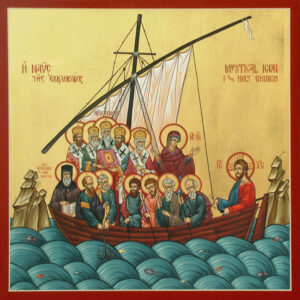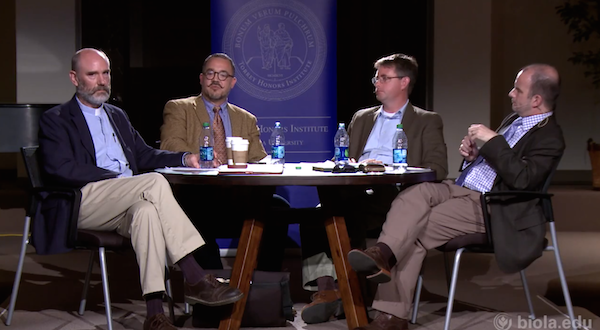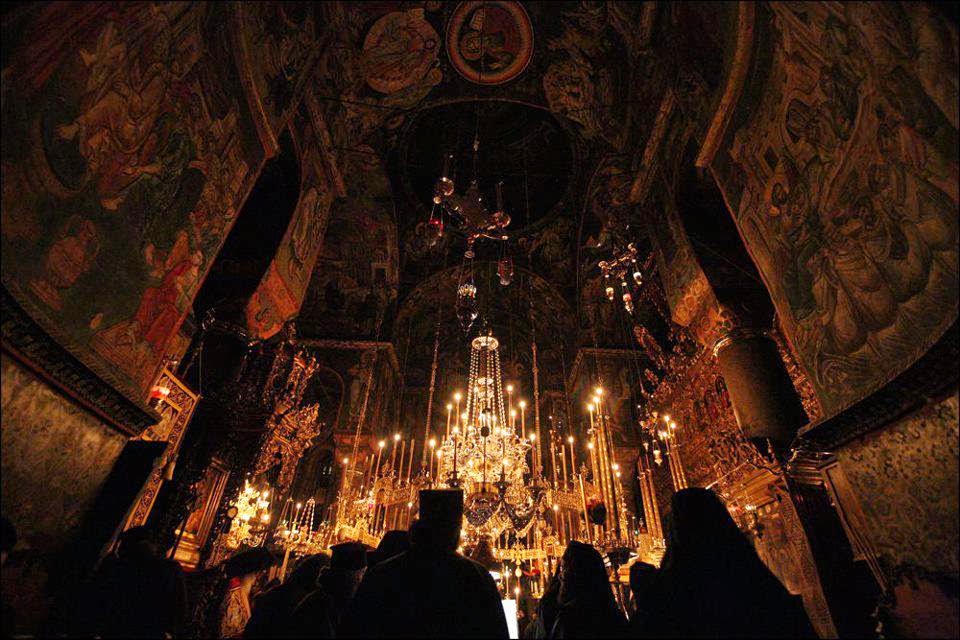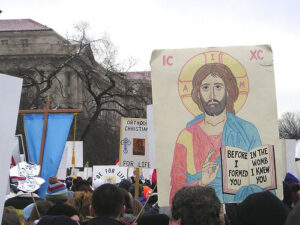The recent “Future of Protestantism” hosted by Biola University on 30 April 2014, is not the only forum where the issue has been raised. A similar conversation took place between Stanley Hauerwas and Albert Mohler in 2012 titled “Nearing the End.”
Stanley Hauerwas, a widely respected theologian, is in Mohler’s words a “high church Mennonite.” Albert Mohler is President of Southern Baptist Theological Seminary in Louisvilee, Kentucky.
This conversation between a Baptist and an Anabaptist makes for an interesting contrast to the “Future of Protestantism” panel which was comprised mostly of Reformed theologians.
Evangelicalism in a Buyer’s Market
Prof. Hauerwas used the metaphor of the religious marketplace to describe the contemporary situation of American Protestantism.
But I suspect it’s true in most places because basically a buyers’ market, that very description, reproduces the presumption that you live in a demand economy that says that the buyer is supreme and they get to buy what they want and therefore… (Emphasis added.)
This leads to a number of interesting insights. Hauerwas observed that because American Evangelical congregations are in a buyer’s market it is very difficult to form a disciplined congregational life. Albert Mohler concurred noting:
When Stanley Hauerwas talks about the buyer’s market for religion in America, he’s onto something that evangelicals ought to notice and notice very carefully. And that is in fact that that is indeed an apt metaphor for our society at large, but it also, if we’re not very careful, a dynamic that is experienced by many churches and denominations, not only in the Protestant mainline, where he mentions all those brand-named denominations jockeying to retain their membership and a declining membership base, but it’s also the case that there are many in American evangelicalism who basically think of the gospel as something to be packaged and sold. (Emphasis added.)
American Protestantism with its free church tradition has given rise to a multiplicity of denominations. Membership is a matter of individual choice; one is not bound to a particular church body. One can move one’s membership as one sees fit. With the recent erosion of denominational identity, church hopping and church shopping have increased among Protestants. Within this frame outreach is the equivalent of marketing outreach, the Gospel as a commodity, and church members as clientele. Evangelical churches that are non-confessional in doctrine, built around the popularity of a charismatic pastor, independent of the larger church, and ministries designed to meet people’s needs can be likened to a shopping mall; designed to maximize the influx of clients or attendees. This has resulted in church staff being under “the pressure to produce results.”
The religious market place has also contributed to a minimalist approach to the Christian faith. Downplaying doctrinal distinctives makes a church more accessible to prospective members (potential customers) and lowers the cost of joining. However, doctrinal minimalism has hidden costs. It weakens the sense of theological identity as well as commitment to the local church. This explains the appeal of the recent neo-Reformed revival among Evangelicals. The neo-Reformed emphasis on theological rigor and doctrinal precision can be seen as rooted in a need for theological identity. Their stress on covenant and disciplined church life can be seen as a reaction to libertarian individualism rife in popular Evangelicalism.
If Hauerwas’ metaphor of Evangelicalism being in a buyer’s market holds true then the question needs to be raised as to whether Peter Leithart’s Reformational Catholicism can ever expand beyond being a niche market. Leithart’s call for “Pentecostals attuned to the Christian tradition” (20:14), “Baptists who love hierarchy” (20:17), “liturgical bible churches” (20:22) runs against the grain of specialization and niche marketing that underlie Protestant denominationalism. Asking churches to give up their distinctives is tantamount to their surrendering their identity. Many would lose members and end up closing their doors.
What Hauerwas referred to as a buyer’s market is largely the result of Protestantism’s response to two aspects of modernity: urbanization and consumerism. The resultant incoherence of Protestantism has caused many Evangelicals to investigate the early Church, the church fathers, and liturgical worship. This in turn has resulted in growing numbers to exit Protestantism altogether for historic traditions like Orthodoxy and Roman Catholicism. See: “A Protestant Exodus?”
Orthodoxy in the Religious Marketplace
This raises the question: How does Hauerwas’ religious marketplace metaphor apply to Orthodoxy? In many ways Orthodoxy is a latecomer to the American religious market. Many of the Orthodox parishes originated in the waves of immigrants in the late 1800s and early 1900s: Greece, the Balkans, Serbia, Ukraine, Russia, and Palestine. Designed to meet the spiritual needs of the immigrant communities, many ethnic parishes ended up perpetuating the culture of the “old country.” Oftentimes, this was not so much niche marketing as it was a closed shop. This state of affairs began to change with the influx of converts in the 1980s and 1990s. Today Orthodoxy in America is at the cusp of change, from ethnic Orthodoxy whose identity is rooted in the culture of the “old country” to an Orthodoxy whose identity is rooted in American culture. And from a closed shop to evangelistic communities committed to fulfilling the Great Commission (Matthew 28:19-20).

Turbo Qualls becoming Orthodox
What many Protestant converts find appealing about Orthodoxy is its ancient faith and liturgy. It can be expected that Orthodoxy will hold fast to Apostolic Tradition into the twenty second century and beyond, while Protestant denominationalism will continue to mutate and morph into forms barely recognizable to those living today. The future of Orthodoxy in the twenty first century depends on it being able to enter into the mainstream of the religious market. This depends on Orthodoxy’s cultural accessibility (all English liturgies) and geographic accessibility (at least within an hour’s driving time). There are signs that Orthodox evangelism is bearing fruit resulting growing numbers of converts. Saint Barnabas Antiochian Orthodox Church in Costa Mesa, California, is one example of effective outreach and catechumenate. With no special program for outreach but ordinary parish life, Saint Barnabas has reached out not just to Evangelicals but also to the younger generation brought up on punk rock, tattoos, and turned off by an overly materialistic American culture. See: “Christian Tattoo Artist Turbo Qualls: An Interview for the Two Cities.”
Discipleship and Catholicity
Like Peter Leithart, Stanley Hauerwas touched on Evangelicalism’s need to regain the catholic dimension of Christianity. Another concern of Hauerwas was the way Evangelicalism made church secondary to Christian discipleship.
…. But one of the great problems of Evangelical life in America is evangelicals think they have a relationship with God that they go to church to have expressed but church is a secondary phenomenon to their personal relationship and I think that’s to get it exactly backwards: that the Christian faith is meditated faith. It only comes through the witness of others as embodied in the church. So I should never trust my presumption that I know what my relationship with God is separate from how that is expressed through words and sacrament in the church. (Emphasis added.)
Where Protestantism emphasized the individual, the catholic dimension emphasizes the Christian life in community. Hauerwas noted:
I need to read the Bible with other people. And that has pretty much been lost. Let me say in that regard that one of the other things that worries me about evangelicalism is I’m afraid it’s got the Bible and now, and exactly how it is that you reconnect evangelical life with the great Catholic traditions, I think is part of the challenges for the future because you need to read the fathers reading Scripture as part of our common life if we are to sustain a sense that we don’t get to make Christianity up. We receive it through the lives of those who have gone before and that just becomes crucial for us to be able to survive in which we find ourselves. (Emphasis added.)
Like Peter Leithart, Dr. Hauerwas saw the recovery of the Eucharist as critical to the future of the church.
Well, let me say one of the things I would have us to go is a much richer, liturgical life than I think is the case in many evangelical and Protestant mainstream churches. I think a recovery of the centrality of Eucharistic celebration and why it is so central is just crucial for the future of the church. (Emphasis added.)
It is interesting that for someone who comes from the Anabaptist tradition; Stanley Hauerwas has some kind words about the First Ecumenical Council!
Well, I want to be careful with that word rational because I think nothing is more rational than Christian Orthodoxy. I think the Nicaea account of Trinity is an extraordinary development that is a tradition thinking through its fundamental commitment in a manner that is intellectually compelling.
However, the Nicene Creed is more than the product of rational intelligence. Orthodoxy believes that the Holy Spirit guided the bishops in their defense of the Gospel against the heresy of Arianism. Because the Nicene Creed represented the mind of the Church (and not individuals), it was able to unify the early Church.
Hauerwas’ call for the recovery of catholicity, the Eucharist, and the Nicene Creed has much in common with Pastor Leithart’s “Reformational Catholicism.” The similarities between Hauerwas and Leithart is significant in that it shows a similar concerns being voiced not just in Reformed circles but also among the Baptists and Anabaptists. This points to a widespread hunger for catholicity among Protestants.
Michael Spencer — “Internet Monk”
The late Michael Spencer’s “The Coming Evangelical Collapse” written in 2009 represents another part of the conversation. Originally a blog posting on the Internetmonk.com the article was later published by the Christian Science Monitor giving it a much wider circulation. Where Stanley Hauerwas is a high profile theologian, the late Michael Spencer worked as a youth minister then as a Baptist pastor. In 2000, he began to blog and in time became one of the most popular Evangelical bloggers. Part of Michael Spencer’s popularity is due to his ability to give voice to a quiet shift taking place in the Evangelical subculture, the emergence of post-Evangelicalism. While not as measured and erudite as Stanley Hauerwas, Michael Spencer wrote boldly from the frontline of Christian ministry.
We are on the verge – within 10 years – of a major collapse of evangelical Christianity. This breakdown will follow the deterioration of the mainline Protestant world and it will fundamentally alter the religious and cultural environment in the West.
He used bold unguarded language in his famous article.
Millions of Evangelicals will quit. Thousands of ministries will end. Christian media will be reduced, if not eliminated. Many Christian schools will go into rapid decline. I’m convinced the grace and mission of God will reach to the ends of the earth. But the end of evangelicalism as we know it is close.
He also predicted an anti-Evangelical turn in American culture.
Within two generations, evangelicalism will be a house deserted of half its occupants. (Between 25 and 35 percent of Americans today are Evangelicals.) In the “Protestant” 20th century, Evangelicals flourished. But they will soon be living in a very secular and religiously antagonistic 21st century.
Michael Spencer did not claim to be a prophet. He wrote as an observer who saw both dangers and promise in the Evangelical movement. It is now five years since the article was first published in 2009. There have been some notable shifts, e.g., the rapid and widespread legalization of same-sex marriage and reports of the growing percentage of Americans who identify as unchurched, nothing as dire or cataclysmic as Michael Spencer predicted. But if current trends continue, his 2009 article may well prove prescient.
Dr. Hauerwas view of Evangelicalism’s future is just as grim as Michael Spencer’s.
I think evangelicalism is destined to die of its own success and it will go the way of mainstream Protestantism because there’s just—it depends far too much on charismatic pastors, and charisma will only take you so far. Evangelicalism is constantly under the burden of re-inventing the wheel and you just get tired.
In terms of the religious market we can expect to see three trends. One, the continued decline of mainline Protestant denominations into obscurity. Two, this will be followed by the decline of Evangelicalism. Evangelical Protestantism is already at its peak; its growth rate has stalled for the past several years, a sign that its decline may have already started. There is a recent report that the Southern Baptist Convention, one of the largest Protestant denominations, has been experiencing declining membership since 2005. But the decline of Evangelicalism is not likely to become a major trend until the 2050s. Three, the next Protestant wave may come from the charismatics and Pentecostals. But the wild card factor that hasn’t yet received much attention is the implication of the shift to a post-Christian society for the American religious market.
The Larger Conversation
The recent Biola forum is but one among many going on among Evangelicals today. What I find intriguing is the fact that there was a time not too long ago when Evangelicalism’s existence and future was an unquestioned given. That so many are discussing the matter seriously points to something in the air. It is like the uneasiness that animals sense before the onset of a great calamity. I had this foreboding premonition about Protestantism after my studies at Gordon-Conwell Theological Seminary in the 1990s. I was deeply troubled by the improbability of bringing biblical renewal to historic mainline denominations on the one hand and the unchecked trendiness of Evangelicalism on the other. The pervasive maladies of modernity that afflicted Protestantism in both its liberal and evangelical expressions caused me to look into the early Church. What I found was a unity of faith that spanned the Roman Empire and continued to endure in the Orthodox Church. I found in Orthodoxy a catholicity of faith that Leithart and Hauerwas are longing for.
 It also struck me that Orthodoxy being rooted in Tradition is capable of riding out a hostile and increasingly post-Christian society. One of the images used to describe the Orthodox Church is that of Noah’s Ark.
It also struck me that Orthodoxy being rooted in Tradition is capable of riding out a hostile and increasingly post-Christian society. One of the images used to describe the Orthodox Church is that of Noah’s Ark.
I found comfort in the stories of the early Christian martyrs. But I was also impressed that the Orthodox Church of the twentieth century managed to survive Communism, despite the systematic destruction of churches, slaughter of faithful clergy and laity, and many who collaborated with the Soviet regime.
This has implications for the recent warnings about a post-Christian society. I suspect that many Christians, Protestants and even Orthodox, are not ready for this new hostile religious market. We need to heed Jesus’ warning:
As long as it is day, we must do the work of him who sent me. Night is coming, when no one can work. (John 9:4; NIV)
Robert Arakaki
Further Readings
“The Post-Evangelical Option: An Interview with Michael Spencer” in Modern Reformation. Eric Landry and Michael Spencer.
“The Nature and Future of Protestantism” in The Calvinist International. Peter Escalante.
“Back to the Future for Protestantism?” in OrthodoxBridge. Robert Arakaki.
“Protestantism’s Fatal Genetic Flaw” in OrthodoxBridge. Robert Arakaki.
“Christian Tattoo Artist Turbo Qualls: An Interview for the Two Cities” in TheTwoCities.com. Nathaniel Warne and Turbo Qualls.






Recent Comments